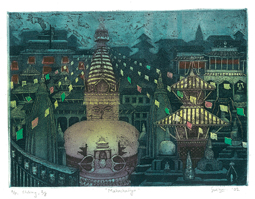One man saw a person lying down on the street in winter. He was interested to help him but he did not have money to give. What he did was he just put his warm hand on the man’s cold hand and gave warmth to him. And the poor man said: ‘You gave me bigger things than others, things you cannot measure with money’. In that cold time, he gave warmth to that person. We cannot give physical help, but we can give this.”
This poignant anecdote came from Kailash Kumar Shrestha, one of Nepal’s up-and-coming young artists.
In Nepal, eons of history and culture intermingle with modernization as east meets west to produce a rich, diverse and deep sense of art and its meaning.
 There is no shortage of talent, yet what the country does lack are the resources and opportunities available for artists to fully immerse themselves in their craft. In any culture, it’s incredibly hard to make a living as an artist and they are often forced to keep day jobs to make ends meet. More often than not, the exhaustion and mundane nature of this work dulls the artist’s inspiration, sucking them dry of creative juices.
There is no shortage of talent, yet what the country does lack are the resources and opportunities available for artists to fully immerse themselves in their craft. In any culture, it’s incredibly hard to make a living as an artist and they are often forced to keep day jobs to make ends meet. More often than not, the exhaustion and mundane nature of this work dulls the artist’s inspiration, sucking them dry of creative juices.
In steps the Australian Himalayan Foundation.
This year marks the 50th anniversary of Nepal-Australia diplomatic relations, and what better way to celebrate the friendship and mutual respect formed between the two countries than through art.
Based in Australia, the Australian Himalayan Foundation (AHF) aims to support the people of the Himalaya in projects related to education, health, environment and culture.
Established in 2008 by Margie Thomas and AHF director Garry Weare, its Himalayan Arts Scholarship Program helps talented young artists pursue their dream of receiving international recognition.
“I did this in honour of my dear, lifelong friend Murray Zanoni, who lived on the proceeds of his art until he died – not an easy feat – and left behind a small amount of cash. It was important to me to really make this small legacy I’d been entrusted with count, so I set up this art award through the AHF. When I was looking around at how to make this work, I met Sangeeta (Thapa) who introduced me to Kailash and Sushma. The rest is history,” says Thomas.
Sangeeta Thapa is the curator of Siddhartha Art Gallery.
“Recommending two names was not difficult. I had met Kailash and Sushma on one of my many trips to the Kathmandu University (KU) Department of Art and Craft in Bhaktapur. They were enrolled in the BFA (Bachelor of Fine Arts) program and were, in fact, the first batch of students at KU, which began its arts program in 2004. I made the trip to Bhaktapur every now and then as I was curious to know what the students were doing, and because I was duty bound. Aidan Warlow, founder and program director of KU, had asked me to join the subject committee of this art institution,” says Thapa.
“Two of the outstanding students of this time were Kailash Shrestha and Sushma Sakya. I followed the evolution of their work with interest. Their graduation shows in 2007 showcased very promising work and were received very well. I exhibited a small selection of their works at the gallery as I believe it is important to promote emerging artists.”
Newars are renowned for their artisanship, particularly in the Kathmandu Valley, so it is not surprising to find that Sakya and Shrestha belong to the Newar community.
Although the pair shares a culture, an award, artistic ability and a spookily similar chickenpox mark on their foreheads, their background and artistic styles are very different.
Sakya, now in her 30s, was born and raised in Patan: “We are seven sisters only. I don’t have any brothers. We are all under the same roof, but all my sisters are doing their own jobs in business. I am the only person who is in this art field. I remember drawing the Lakhe every year, the dance performed in Patan,” she says.
Lakhe masks depicting Buddhist and Hindu figures are popular in the Kathmandu Valley, and are usually worn for traditional dance ceremonies during Newari festivals.
Shrestha grew up in Dolka, Dolakha District, around 200 kilometers from Kathmandu: “In my village, there were no vehicles, no lights. I didn’t know about painting. But when I was in class four, one of my friends came from India and he used to draw very beautifully. I would always get inspired by him.”
He began with calligraphy, cutting bamboo to etch out the elegant characters. Several years later, he started using red and white clay, or vegetable dyes to make his own paints.
“I started like that, but I didn’t know how to paint and draw. And then I came to Kathmandu. I didn’t know how I came in this field, but I am very happy now. I am very proud of myself. I don’t want to be like others. I want to be myself, and that’s why I am doing this,” he says.
Like Sakya, Shrestha’s brothers work in the business field but support him in his desire to do something different, particularly his elder brother Durga Raj. “Without him I couldn’t do this. He’s the backbone, supporting me in every step of my life. I can’t forget him. He’s like my godfather.”
While 25-year-old Shrestha focuses on the human form, Sakya’s interests lie in religious architecture. “I’m especially inspired by the vacant space of the chaitya (a shrine-including stupa). Chaitya is dedicated to Buddha. I interpret that anyone can take that vacant space, but one has to get enlightenment. Everyone is welcome to enlightenment, but people are not trying to achieve it. That’s why it’s still vacant.”
Shrestha refuses to call himself an artist, instead preferring the term ‘art lover’ or ‘art student’. “To become an artist is very tough. You have to go a long way. It is only because of the AHF we are now here. That help was a turning point in our lives. We used to have trouble buying canvases and paints.”
Both Sakya and Shrestha have proven their innate creative ability and dedication to their craft with impressive portfolios. Although both teach part-time, Shrestha working with children and Sakya with students at KU, the scholarship allows them to continue developing as artists.
“This scholarship is a great thing for me. I think without it I wouldn’t be exploring all these kinds of mediums. I am able to buy all these materials without taking money from my parents, so that’s a great improvement,” says Sakya, who experiments with mediums like video and installation art besides painting.
Shrestha agrees. “Creating is not a joke. You need space. I always say that either God creates or artists create. For that kind of environment we need a space. Because of the scholarship, I could hire this space and work freely. I can create a space where I can meditate on my work.”To ensure the award is self-sustaining, each year’s winners donate one major and one minor piece to the AHF to be auctioned off in Australia. This has the dual advantage of generating interest and demand for Nepali art overseas, while providing funding to continue the scholarship the next year.
While artists can rarely offer financial support themselves, in line with his beautiful anecdote, Shrestha believes art can offer a warm hand in times of adversity.
“We need to have more sincerity. To do our best. Now, in Nepal, we are fighting for our rights. This is a time to fight with the mind, not with physical things. There are many physical wars. Everybody’s fighting, everybody’s killing. I think God has given us a mind of our own. Art has taught me how to become me. It’s a process of discovering self through art.''
Sakya and Shrestha’s exhibition will be officially launched by HE Susan Grace, Australian Ambassador to Nepal, at 5:30 pm on Sunday April 4 at Siddhartha Art Gallery, Barber Mahal Revisited. The exhibition will run until 21 April, 2010. gFor more about the exhibition and the work the Australian Himalayan Foundation does in Nepal, go online to http://siddharthaartgallery.com/ and http://australianhimalayanfoundation.org.au/.
The author is a freelance writer living in Kathmandu. Email: miriam.fisher@hotmail.com









